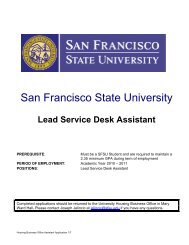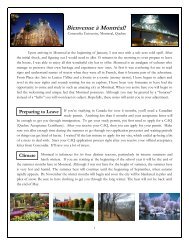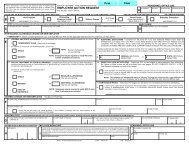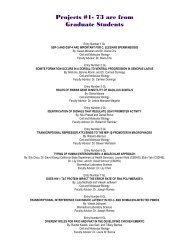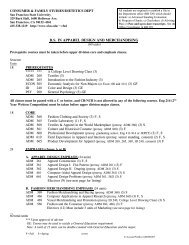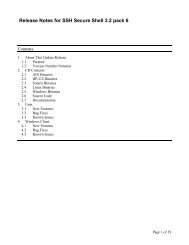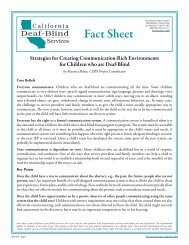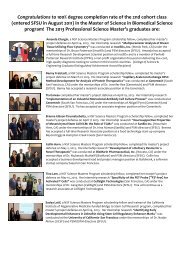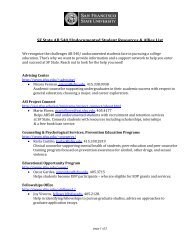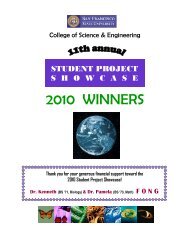32. Using Math to Untangle DNA - San Francisco State University
32. Using Math to Untangle DNA - San Francisco State University
32. Using Math to Untangle DNA - San Francisco State University
Create successful ePaper yourself
Turn your PDF publications into a flip-book with our unique Google optimized e-Paper software.
<strong>Using</strong><br />
<strong>Untangle</strong> <strong>Math</strong><br />
<strong>to</strong><br />
<strong>DNA</strong><br />
The study of <strong>DNA</strong> <strong>to</strong>pology relies heavily on both math and<br />
biological structures and <strong>to</strong> understand<br />
32
y Annie Bautista<br />
biology <strong>to</strong> unravel the shape and geometry of complex<br />
the enzymatic actions that affect <strong>DNA</strong> <strong>to</strong>pology.<br />
Imagine this<br />
compacting a 2-meter-long string in<strong>to</strong> a tiny<br />
ball just 0.005 millimeters across—much<br />
narrower than the width of a human hair.<br />
The probability of the condensed string remaining<br />
untangled is rather slim. Our own<br />
bodies, however, pull off this improbable<br />
feat every day. Each of our 100 trillion cells<br />
plays some active role in movement, digestion,<br />
sensation, and so on, and functions<br />
by means of genetic instructions encoded<br />
on a 2-meter-long “string” of <strong>DNA</strong> packed<br />
inside the microscopic nucleus. How does<br />
gossamer string remain untangled despite<br />
its tight packaging? And how does the<br />
tight compaction still allow accessibility for<br />
decoding and accurate replication? SF <strong>State</strong><br />
Associate Professor Mariel Vazquez, a pioneer<br />
in mathematical biology, studies <strong>DNA</strong><br />
compaction in normal cells, as well as <strong>DNA</strong><br />
rearrangements and other aberrations in<br />
cells with erroneous genetic behavior such<br />
as breast cancer cells. Her approach comes<br />
from pure mathematics and involves computational<br />
<strong>to</strong>ols. The outcome, however, could<br />
someday help others save lives.<br />
33
<strong>Math</strong>ematicians have created <strong>to</strong>ols from<br />
computational and analytical knot theory<br />
<strong>to</strong> provide a detailed picture of what <strong>DNA</strong><br />
looks and acts like when packaged in<br />
confined environments, and in turn,<br />
how enzymes change the <strong>to</strong>pology of <strong>DNA</strong>.<br />
Mariel Vazquez, Associate Professor of <strong>Math</strong>ematics<br />
In eukaryotic cells (such as human cells),<br />
<strong>DNA</strong> molecules must be “supercoiled,”<br />
or tightly folded, and also packaged in<br />
chromosomes. The packaging requires assistance,<br />
and proteins called his<strong>to</strong>nes supply<br />
it. The <strong>DNA</strong> of simple organisms such as<br />
bacteria is also supercoiled and subjected<br />
<strong>to</strong> various levels of compaction. Bacterial<br />
<strong>DNA</strong> is circular and is therefore prone <strong>to</strong><br />
becoming knotted. While the <strong>DNA</strong><br />
molecule naturally exists in a<br />
<strong>to</strong>pologically stable conformation,<br />
the long molecule must<br />
unravel during <strong>DNA</strong><br />
replication and<br />
transcription.<br />
The cell is fully<br />
equipped with<br />
enzymes <strong>to</strong> facilitate<br />
the efficient duplication<br />
of the genetic code, as well<br />
as the transcription of<br />
<strong>DNA</strong> in<strong>to</strong> RNA and<br />
the translation of<br />
RNA in<strong>to</strong> proteins.<br />
When the<br />
activity of these enzymes<br />
is altered or poorly<br />
regulated, knots and links<br />
can occur within the ultra-long<br />
<strong>DNA</strong> molecule. This may result in<br />
chromosomal abnormalities and cell death.<br />
To prevent <strong>DNA</strong> knots and links, which are<br />
obviously undesirable <strong>to</strong>pological forms,<br />
cells use enzymes called <strong>to</strong>poisomerases.<br />
Mariel Vazquez studies the way type<br />
II <strong>to</strong>poisomerases and enzymes with related<br />
activity called site-specific recombinases<br />
change the <strong>to</strong>pology of <strong>DNA</strong>. To do so, she<br />
employs circular <strong>DNA</strong> molecules such as<br />
the circular chromosomes of the bacteria<br />
Escherichia coli (E. coli). Before a bacterial<br />
cell divides, its single circular chromosome<br />
is replicated, resulting in two interlinked<br />
<strong>DNA</strong> circles. When events such as knotting<br />
or linking occur in the circular strands, type<br />
II <strong>to</strong>poisomerases can return the <strong>DNA</strong> molecules<br />
<strong>to</strong> their native, untangled state. In this<br />
way, they function <strong>to</strong> regulate the <strong>to</strong>pology<br />
of <strong>DNA</strong> by removing unwanted knots and<br />
links in preparation for cell division.<br />
In her studies, Vazquez focuses on the<br />
cell’s ability <strong>to</strong> faithfully replicate its <strong>DNA</strong><br />
and <strong>to</strong> produce unlinked <strong>DNA</strong> molecules.<br />
Vazquez’s doc<strong>to</strong>ral advisor from Florida<br />
<strong>State</strong> <strong>University</strong>, Dr. De Witt Sumners,<br />
likes <strong>to</strong> say that “Mother Nature’s solution<br />
<strong>to</strong> the entanglement problem is <strong>to</strong>poisomerase.”<br />
The enzyme’s activity–passing<br />
one strand of <strong>DNA</strong> through another and<br />
alleviating <strong>to</strong>rsional stress <strong>to</strong> eliminate knots<br />
and links–is especially important in newly<br />
replicated <strong>DNA</strong>. Because <strong>to</strong>poisomerases<br />
have such a pivotal role as safe-keepers<br />
of <strong>DNA</strong> <strong>to</strong>pology, malfunctions can have<br />
catastrophic consequences.<br />
34
Noting this, researchers realized that<br />
deliberately blocking <strong>to</strong>poisomerase activity<br />
could potentially lead <strong>to</strong> cell death–and<br />
therefore allow for new types of antibiotics<br />
and anti-cancer drugs. Pharmaceutical<br />
researchers have designed certain drugs<br />
<strong>to</strong> inhibit the enzymes in bacterial cells:<br />
The broadspectrum antibiotic ciproxin,<br />
for example, which is widely used <strong>to</strong> fight<br />
bacterial infections, blocks type II <strong>to</strong>poisomerases.<br />
Likewise, e<strong>to</strong>posides are used in<br />
combination with other drugs during chemotherapy<br />
for a variety of cancers, including<br />
lung cancer and lymphona. E<strong>to</strong>posides<br />
cause unrepairable damage in tumor cells<br />
by blocking their <strong>to</strong>poisomerase activity.<br />
Drugs of this type can potentially cause an<br />
accumulation of supercoils, knots or links<br />
she explains it, she solves the biological<br />
problem by “modeling the [underlying]<br />
process using pure math, and then translating<br />
the output of the models back in<strong>to</strong> their<br />
original context”–the cell.<br />
<strong>Math</strong>ematicians have created <strong>to</strong>ols<br />
from computational and analytical knot<br />
theory <strong>to</strong> provide a detailed picture of what<br />
<strong>DNA</strong> looks and acts like when packaged in<br />
confined environments, and in turn, how<br />
enzymes change the <strong>to</strong>pology of <strong>DNA</strong>.<br />
“Imagine circular rubber bands as <strong>DNA</strong>,”<br />
says Vazquez, “ and then stuff them in<strong>to</strong><br />
a tiny box. Each band will produce some<br />
interesting configurations, but every time<br />
you pull [a band] out, it is still just a circle.”<br />
Now, she goes on, “imagine that little<br />
enzymes are placed inside the box. Put<br />
program “Knotplot.” Vazquez has also authored<br />
“TangleSolve,” a Java applet for the<br />
<strong>to</strong>pological analysis of site-specific recombination.<br />
These programs allow researchers <strong>to</strong><br />
take experimental data and reproduce and<br />
reinterpret it using rigorous mathematical<br />
analysis. <strong>Using</strong> these advanced programs,<br />
mathematicians are able <strong>to</strong> “investigate<br />
beautiful mathematical problems that arose<br />
from the original biological problems,” says<br />
Vazquez.<br />
Mariel Vazquez’s fusion of math and<br />
biology bridges many fields of research. In<br />
April 2002, the American <strong>Math</strong>ematical<br />
Society (AMS) <strong>Math</strong> Awareness month<br />
highlighted the importance of mathematics<br />
in genomics research. As researchers<br />
complete the job of sequencing the entire<br />
that seriously hinder the cell’s ability <strong>to</strong><br />
manipulate its <strong>DNA</strong> genome and thus <strong>to</strong><br />
divide normally and grow.<br />
The study of <strong>DNA</strong> <strong>to</strong>pology relies<br />
heavily on both math and biology <strong>to</strong><br />
unravel the shape and geometry of complex<br />
biological structures and <strong>to</strong> understand the<br />
enzymatic actions that affect <strong>DNA</strong> <strong>to</strong>pology.<br />
Vazquez applies <strong>to</strong>pology, geometry<br />
and computational <strong>to</strong>ols <strong>to</strong> study the shapes<br />
of circular <strong>DNA</strong> molecules in solution, as<br />
well as in confinement, and <strong>to</strong> understand<br />
the way enzymes such as type II <strong>to</strong>poisomerases<br />
allow cells <strong>to</strong> function smoothly. As<br />
this rubber band inside again, very tightly<br />
packed… The enzymes cut the <strong>DNA</strong>,<br />
transfer it through the break, reseal it, and<br />
do that many times. When you take the<br />
rubber band out it is very, very likely <strong>to</strong> be<br />
knotted.”<br />
Jointly with her close collabora<strong>to</strong>r,<br />
Javier Arsuaga, Vazquez has developed<br />
computer software of various kinds <strong>to</strong><br />
understand the making and behavior of<br />
<strong>DNA</strong> knots and links. Together with their<br />
former postdoc, Rob Scharein, the two have<br />
contributed new knot theory software <strong>to</strong><br />
the widely used computational knot theory<br />
Page 34 lower left:<br />
Computer representation of a <strong>DNA</strong> knot as a<br />
polygonal chain in the simple cubic lattice.<br />
Page 35:<br />
Random and spooling model of <strong>DNA</strong> packing<br />
in bacteriophage capsids. Colors indicate<br />
contiguous <strong>DNA</strong> regions.<br />
Graphics courtesy of Dr. Vazquez.<br />
35
human genome, the AMS states in a press<br />
release, “…attention can shift from the job<br />
of finding genes…<strong>to</strong> understanding them.”<br />
<strong>Using</strong> mathematics <strong>to</strong> study the shape and<br />
geometry of <strong>DNA</strong> will “provide information<br />
about the biological function of <strong>DNA</strong>.”<br />
Vazquez’s software development and study<br />
of enzymes that change the <strong>to</strong>pology of<br />
<strong>DNA</strong> is an important arm of that work.<br />
Vazquez’s long-standing passion for<br />
math and biology laid the foundation for<br />
her educational and her professional career.<br />
During and after high school, she gravitated<br />
<strong>to</strong>ward both subjects. She enrolled as an<br />
undergraduate at the National Au<strong>to</strong>nomous<br />
<strong>University</strong> of Mexico (UNAM). At that<br />
time, however, they offered no interdisciplinary<br />
programs in the two fields. Vazquez<br />
Analysis of Site-Specific Recombination:<br />
Gin and Xer systems. Next she worked as a<br />
Postdoc<strong>to</strong>ral Fellow in <strong>Math</strong>ematics at UC<br />
Berkeley. While there, she split her time<br />
between men<strong>to</strong>ring undergraduate research<br />
projects in <strong>DNA</strong> <strong>to</strong>pology and using math<br />
and computers <strong>to</strong> model the chromosomal<br />
rearrangements that result from radiation<br />
damage. In 2005, she became an assistant<br />
how type II <strong>to</strong>poisomerases unknot <strong>DNA</strong><br />
with funding from the National Institutes<br />
of Health (NIH). Jointly with Javier Arsuaga,<br />
Assistant Professor of <strong>Math</strong>ematics<br />
at SF <strong>State</strong>, she has studied the <strong>to</strong>pology of<br />
bacteriophage <strong>DNA</strong> with funding from the<br />
National Science Foundation. Arsuaga and<br />
Vazquez have funding from the National<br />
Center On Minority Health And Health<br />
Disparities <strong>to</strong> study CGH array data from<br />
breast cancer patients using techniques<br />
from computational <strong>to</strong>pology. For the latter<br />
study, Vazquez and Arsuaga are searching<br />
for chromosomal changes associated with<br />
recurrent breast cancer in early stage patients.<br />
They are also hoping <strong>to</strong> identify <strong>to</strong>pological<br />
signatures in the <strong>DNA</strong> that allow<br />
an accurate prediction of who is most likely<br />
In her studies, Vazquez focuses<br />
on the cell’s ability<br />
<strong>to</strong> faithfully replicate<br />
its <strong>DNA</strong> and <strong>to</strong><br />
produce unlinked<br />
<strong>DNA</strong> molecules.<br />
focused on mathematics and fell in love<br />
with <strong>to</strong>pology and geometry. However, her<br />
interest in biology remained. To graduate<br />
from UNAM in 1995, she completed a<br />
thesis called Applications of Knot Theory<br />
<strong>to</strong> the Study of <strong>DNA</strong>. She pursued her<br />
doc<strong>to</strong>rate at Florida <strong>State</strong> <strong>University</strong> and<br />
in 2000, wrote a dissertation called Tangle<br />
professor at SF <strong>State</strong>.<br />
In her labora<strong>to</strong>ry, she has continued<br />
her work on the tangle analysis of Xer<br />
recombination, which is the subject of<br />
the CAREER award that she obtained<br />
earlier this year from the National Science<br />
Foundation. Her group also undertakes the<br />
mathematical and computational analysis of<br />
<strong>to</strong> experience a cancer recurrence. Writing<br />
in the journal Bioinformatics in 2002,<br />
mathematician Angela Torres states, “The<br />
fusion of mathematics and biology will<br />
result in a new era of molecular medicine,<br />
when the diagnosis, treatment and prevention<br />
of disease will be individual-specific<br />
and thus more successful.”<br />
36
In addition <strong>to</strong> her research, Vazquez<br />
teaches several courses and helps organize<br />
professional conferences. Every spring, she<br />
teaches a <strong>DNA</strong> <strong>to</strong>pology course through<br />
the SF <strong>State</strong> math department. She has<br />
also organized many conferences<br />
and symposia in the last few years.<br />
These include the yearly Modern<br />
<strong>Math</strong>ematics Workshop at<br />
SACNAS, SIAM mini-symposium<br />
on New Trends in <strong>Math</strong>ematical<br />
Biology at the joint meetings of the<br />
American <strong>Math</strong>ematical Society<br />
and the <strong>Math</strong>ematical Association<br />
of America (January 2010), the<br />
Fong Symposium at SF <strong>State</strong> in<br />
2010, the <strong>San</strong> <strong>Francisco</strong> International<br />
Meeting on <strong>DNA</strong> Topology<br />
(April 2009), and the annual Biology<br />
and <strong>Math</strong>ematics in the Bay<br />
Area (BaMBA) Day. BaMBA Days<br />
rotate between Bay Area Institutions.<br />
Stanford hosted BaMBA VI<br />
in November 2010. All of these<br />
events, says Vazquez, allow the<br />
public <strong>to</strong> learn the importance of<br />
applying fundamental mathematics<br />
<strong>to</strong> important biological problems.<br />
Vazquez is convinced that an<br />
interdisciplinary approach helps<br />
solve such puzzles, and her research<br />
group at SF <strong>State</strong> reflects that conviction.<br />
Her group and collabora<strong>to</strong>rs<br />
typically include chemists, bioengineers,<br />
computer scientists, biologists,<br />
and mathematicians. “We try<br />
<strong>to</strong> work all <strong>to</strong>gether and it is very<br />
highly vertically integrated,” she<br />
says, meaning that “undergraduates<br />
work alongside graduate students,<br />
research technicians, research fellows,<br />
and faculty members.” This<br />
exposure helps biology majors become more<br />
comfortable with math and its utility in<br />
their research. “Many times, we see biologists<br />
who start a research project and soon<br />
find that they need <strong>to</strong> learn statistics…how<br />
<strong>to</strong> program…more math. That’s when they<br />
realize that math is not so awful after all.<br />
<strong>Math</strong> can be fun,” Vazquez says, “and it is<br />
extremely useful nowadays if you’re a biology<br />
student. Acquiring strong mathematical<br />
skills is very important if you want <strong>to</strong> be<br />
competitive.” v<br />
Page 36 <strong>to</strong>p:<br />
A <strong>to</strong>rus knot diagram.<br />
Page 36 bot<strong>to</strong>m:<br />
Disentangling <strong>DNA</strong> by recombination is illustrated by two black arrows (sites) targeted by a<br />
blue ball (enzyme) along a polygonal chain (<strong>DNA</strong>).<br />
Page 37:<br />
Visual representation of a cloud of points in 3-dimensions. The cloud of points arises from<br />
genomic data of breast cancer patients. Loops indicate contiguous genomic regions.<br />
Graphics courtesy of Dr. Vazquez.<br />
37



